Archive
Chasing a dream: Amateur wines show character, flaws
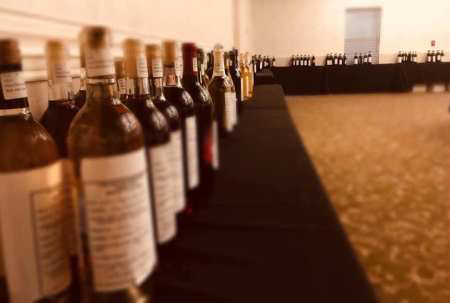
A portion of the 96 entries received this year for the Colorado Amateur Winemakers Competition. As in years past, red wines outnumbered all others. Photo by Cassidee Shull
On a crystal-bright Saturday morning in early November, I sat down at the Wine Country Inn with five other volunteer judges for the Colorado Amateur Winemaking Competition.
This annual wine judging is but one of the many wine-related events including Colorado Mountain Winefest produced by the Colorado Association for Viticulture & Enology (CAVE).
“This year we have 96 entries, including seven fruit wines, 17 white wines, two ice wines, five rosés and 65 red wines,” CAVE’s tireless executive director Cassidee Shull, who wrangled up the judges, countless wine glasses and a handful of wine openers, said as the day began. “We’ll taste through the wines and at the end choose the top wines to compete for Best of Show.”
That was pretty much the last we saw her as she spent the day, along with CAVE Program Director Melinda Tredway and hard-working volunteers Linda Keltner and Tiffany Sommers, shuttling carts loaded with wine glasses from the bottle room to the judges’ tables and back.
The judging offers amateur winemakers the opportunity to have their wines objectively assessed rather than relying on family and thirsty neighbors.
According to Orchard Mesa grape grower Rusty Price, the competition began at the 1994 Colorado Mountain Winefest at Palisade’s Veteran’s Park.
“The state wine industry was very, very small at the time (nine wineries), we didn’t even have a contest for the pros,” Price said. At the 1993 Winefest, he “hauled about 500 pounds of grapes” to the park for a grape-stomping event. That proved so popular he added an amateur winemakers’ competition the following year. “I think we had seven contestants and I didn’t enter because I was operating it,” said Price. “I think a lot of the wineries around now got their start at that contest.”
Price competed once, in 2000, and his Sunset Mesa Cellars Chardonnay won Best White Wine and Best of Show.
This year’s 96 entries from 27 winemakers provided “great insight into the growth of the Colorado Wine Industry as a whole,” Shull said. “These are the next generation of winemakers and grape growers ready to join this amazing industry.”
The eclectic mix of wines wasn’t unexpected, given the “who knows what will show up” history of the amateur contest.
“Annual entries are like the weather; you never know what you’re going to get,” judge Christine Feller said. “They are sometimes exceptional.”
While nothing this year was exceptional, there were some well-made and very nice wines.
“I really enjoyed the fruit wines,” offered judge Jenne Baldwin-Eaton, former winemaker at Plum Creek Winery and now teaching viticulture and enology at Western Colorado Community College. “They had matching aromatics and flavor.”
Incidentally, 1994 was the first year Baldwin-Eaton (it just Baldwin back then) attended Winefest and soon after landed a job with Erik Bruner, then Plum Creek’s winemaker.
The white wines, both dry and sweet, were generally well-received, a compliment in the sense there weren’t any overly faulty wines and several were close to commercial quality.
Baldwin-Eaton noted some work still needs to be done in the crucial area of balancing acid and sweetness in wines with residual sugar (remaining after fermentation). There also were oxidation (browning) issues in several of the white wines.
This “is part of what makes white wines more difficult to make,” Baldwin-Eaton said.
Red wines are buffered from oxidation by tannins and oak-aging, both of which add complexity to a wine.
That noted, the rosés and red wines received mixed reviews.
Pat Kennedy said “The improvements in the red wine is remarkable” while Feller, who has 20-plus years judging wines in this and other competitions, noted the red wines to her overall were disappointing.
There were “many flaws or challenges the winemakers couldn’t resolve,” Feller later wrote in an email. “Ordinarily, there are several remarkable reds.”
Kennedy, formerly at Talon Wine Brands, also mentioned tasting “seven or eight” oxidized wines.
The most-common flaw reported was over-extraction, caused by leaving the skins and juice together too long.
The process is desirable in some wines but uncontrolled can produce over-developed phenolics, chemicals affecting taste, color and mouthfeel of wines.
Not every winemaker will be pleased with their review but as Baldwin-Eaton noted, the competition offers amateurs valuable experience prior to starting a bonded winery.
“A lot of hard work and labor goes into making small-scale wine, and I am very appreciative of (the winemakers’) efforts,” she said. “By entering their wines and opening themselves up to constructive criticism and praise for what they are doing correctly, it lets me know that they want to improve and increase the quality of their efforts.”
Medals will be awarded Jan. 15 during the 14thannual VinCO Conference & Trade Show at Two Rivers Convention Center. Information at winecolorado.org.
The challenges amateurs face
Why doesn’t every amateur winemaker make wines as good as the pros? Lack of experience, yes, but state enologist Stephen Menke said the biggest holdback for amateurs might well be the cost of good equipment.
Much amateur wine is made in someone’s basement or garage in glass or plastic jugs known as carboys ranging from ½-gallon to 15 gallons.
“For amateurs it’s all self-financed so they tend to go cheap, maybe even water-down the fruit,” Menke said. “It’s hard to do professional style and quality on a really low budget.”
White wines are especially difficult given the special equipment needed to regulate temperatures during fermentation.
White wines “are trying to showcase the varietal fruit components of the wine,” Jenne Baldwin-Eaton said. “If anything goes wrong with a white wine fermentation, it will be hard to hide and you will have lost the nice fruit components.”
Pat Kennedy said during his years at Talon “we worked hard at the cold-stabilization stage in the aging process for the white wines.
“I would imagine that an amateur winemaker wouldn’t have the equipment to chill the wine and keep it cold for a long period of time.”
A major concern, shared with commercial winemakers, is keeping things clean.
“You can get bottle acidity, oxidation, and even some bacterial infections if you don’t pay attention to the details,” Menke said, noting that professionals have the experience and the equipment to deal with such problems.
“The most important thing is knowing how to clean your equipment,” he said. “Eighty percent of our time is spent making sure things are not contaminated.”
Mother’s Day gets ‘Uncorked’ in the West Elks AVA
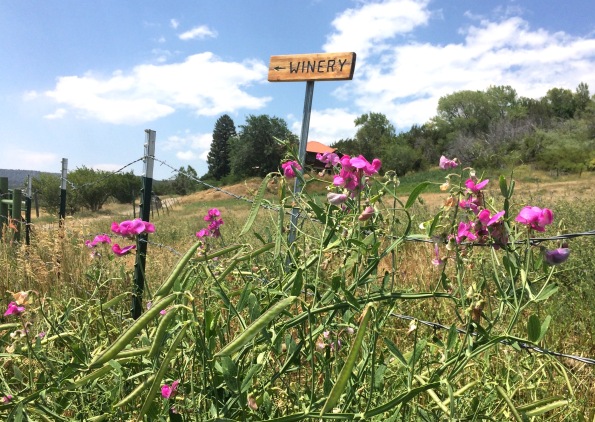
Mother’s Day offers the perfect beginning to a season of winery related dinners and special events in the West Elks AVA and the North Fork Valley. Photo and story by Dave Buchanan.
Some notes on events taking place in the West Elks AVA marking Mother’s Day (Sunday May 13) and beyond:
Mother’s Day Brunch at Alfred Eames Cellars – This is the first in a summer series of monthly smorgasbord-style brunches hosted by Eames and Pam Petersen. Hours: 10 a.m. until 2 p.m., cost is $15 for all you can eat (or until the food runs out). Live music from 11-2 featuring David Sheppard. Reservations requested but not required. Information and directions: 970-527-6290 or www.pams-jammin.com. Email: pvinsong@gmail.com. 11931 4050 Rd, Paonia.
Mother’s Day Dinner featuring Stone Cottage Cellars – The wines of Stone Cottage Cellars and the culinary talents of Chef Chelsea Bookout will be featured Sunday at the Locavore at the Auction House dinner, 530 Grand Ave., Paonia. 6:30 p.m., five courses paired with Stone Cottage Cellars wine, $70 per person. Reservations: PaoniaBreadWorks@gmail.com or 970-527-5376.
North Fork “Uncorked”, which highlights the wineries of the North Fork Valley and West Elks AVA wine country, this year happens June 15-17. Special wine dinners and events throughout the weekend, including two full days of tasting the newest releases and special food pairings at all participating wineries. Dinners are scheduled for June 15 at SkyHawk Winery and Leroux Creek Vineyards; June 16 – Stone Cottage Cellars, and June 17 at Alfred Eames Cellars (9 a.m.- 1 p.m. brunch only). Information: WestElksAVA.com or 970-390-4251.
It’s time for a change, but is it spring or another blast of winter?
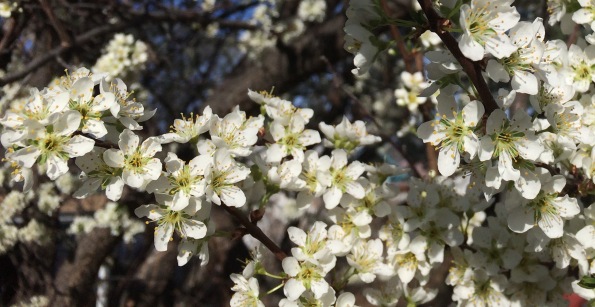
Early heralds of the season to come, these plum blossoms may or may not survive to produce fruit, depending on the weather. Some fruit growers in western Colorado say they get plums and apricots about one year in 10. Story, photos by Dave Buchanan
A change is coming to the high desert of western Colorado. Observant hikers already have noticed miniscule blossoms poking out from desert shrubs, including such early bloomers as shadscale and saltbush.
In the city, winter-weary eyes are greeted by puffy blossoms of plum, apricot and serviceberry, glowing popcorn-white against winter-dark wood.
For fruit growers, however, this means restless nights, knowing it won’t be long until their sleep is broken by the roar of wind machines keeping the frost at bay.
Meanwhile, the vineyards sleep on. Even as eager gardeners eye emerging crocuses and dig into the cool soil as if spring were buried there, the vines wait unperturbed.
The vines are not fooled.
“Everything is still pretty much asleep,” noted Horst Caspari, state viticulturist at the CSU Orchard Mesa Research Station. “They don’t wake up very quickly. Each week they lose some of their cold-hardiness and each week they get closer to waking up.”
Caspari let his eyes wander to the apricot and pluot trees outside his window at the research station near the northwest corner of B and 32 roads on Orchard Mesa. He doesn’t harvest the fruit; the trees are there for decoration and to act as Nature’s calendar of seasons.
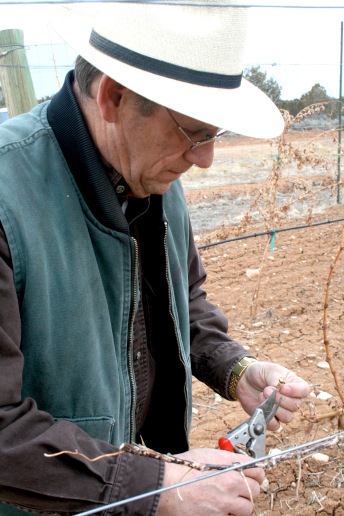
Winemaker Guy Drew of Guy Drew Vineyards in McElmo Canyon near Cortez in southwestern Colorado checks some early bud development in his grape vines. Growers regularly monitor bud growth and survival, looking for hints of the crop to come.
“Once the trees and vines get to bud break, all the cold hardiness changes,” he said. “Look at the apricots. I’d expect we’ll see the first flowers in the valley this week but if it drops to 29 degrees, you’ll lose them.”
Bud break, when nascent buds emerge from the protective cover and show themselves to the world, is when spring really arrives in the Grand Valley, no matter what the calendar or the thermometer says.
When a visitor remarked that his plum tree was “thisclose” to flowering, Caspari laughed.
“Well, you probably won’t have any plums to pick up this fall,” he said.
Records suggest that the last spring frosts are coming come earlier and the first fall frosts arriving later, adding a few days on each end of the Grand Valley’s growing season.
Caspari, who refers to killing frosts below 30 degrees, said that in the 54 years of records the Research Station has kept, the median date for the last frost (below 30 degrees) is April 25 while the first fall frost comes around October 23.
That’s not absolute, he emphasized.
“In 2016, we got hit pretty hard when we had 19.8 degrees on Nov. 16,” he said.
In those years, the same records indicate the valley has picked up “about a week” of frost-free (i.e., not a killing frost) growing, Caspari said.
A few days in the spring and about the same in the fall.
“We definitely have changed in the fall,” he said.
Of course, the changes are not limited to western Colorado.
NASA reports the average global temperature has increased about 0.8-degree Celsius (1.4-degrees degrees F) since 1880.
Two-thirds of that, says NASA, has occurred since 1975, just about the time U.S. wines broke onto the world’s stage at the famed Judgment of Paris.
During the 2017 Vinexpo in Bordeaux, France, growers and winemakers alike voiced concern about a warming climate and its effect on winemaking.
“Vines are very sensitive plants,” Gaia Gaja, co-owner of the 159-year old Gaja Winery in Barbaresco, Italy, told the French Press Agency. “They’re like a thermometer. They register every little variation that there is around them.”
Which brings us to spring of 2018, where things are bit behind last year.
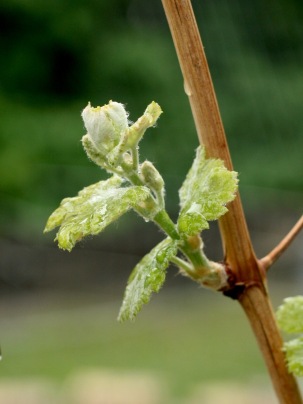
Late March still is too early in the Grand Valley for grape tendrils but it won’t be long until delicate leaves such as these add a shade of green to brown vines.
“I keep track of the budding time of my flowers, my bulbs, and it’s been pretty fascinating,” winemaker Nancy Janes of Whitewater Hill Vineyards said recently. “It has not been unusual historically for me to have crocuses bloom in the middle of February and this year my crocuses are just blooming right now.”
She said the warm days have been balanced by nights dipping into the low 30s “and that’s keeping things pretty dormant.”
Caspari also noted that the spring so far is about two weeks behind 2017.
“Last year we had bud break in the second week of March and we don’t normally get bud break in Chardonnay until the fourth week in April,” he said.
One way to look at the spring re-awakening, said Caspari, is to envision a circle, with winter cold at the bottom and spring warmth at the top. Does the temperature rise gradually, following the arc of the circle, or is there a sudden bottom-to-top jump, bridging the gap and going quickly from winter to spring?
“That changes how you think about what you have to do to have a crop,” Caspari said.
Most grape growers are busy pre-pruning, getting ready for that last flurry of cutting and shaping when the growing season finally arrives. Will it come with a rush or will western Colorado sink back into another spell of winter, delaying the bud break and pushing development later into fall?
Nancy Janes gazed out of her winery at the still-sleeping vineyard sloping away to the north. A few clouds could be seen drifting far over the Bookcliffs in the pale, late-winter sky.
“So far, it’s been a very nice winter for us,” she said. “And you know, grapes aren’t fooled easily. They know when things are ready.”
Time for a drink? Dry winter has grape growers watching the sky

This winter has been neither extremely cold nor extremely wet, and only the first pleases grape growers. Grape vines are being freeze-dried as they lose moisture during the winter months.
If you’ve taken a stroll across your lawn recently, you know how parched things are.
January normally is a dry month for Colorado but until this past week’s smatter of moisture this winter has been especially dry. Certainly not normal, even for the high desert, and home owners in western Colorado have been urged to water trees and landscaping to prevent future damage.
But what do you do when your “landscaping” involves acres of grape vines?
The Grand Valley is no stranger to dealing with cold damage to grape vines. Hard winters (including the devastating winter of 2002/03 and most-recently in 2014) are among the challenges facing grape growers.
But this year, with daytime temperatures still climbing into the high 30s to mid- 40s (at this writing it is 48 degrees in Grand Junction) with nary a lick of snow on the ground, brings a new set of challenges.
Grape vines store a sort of anti-freeze in the form of stored sugars from last year’s photosynthesis but deep cold still can damage or kill buds, trunks and canes.
Also, a long, dry winter can desiccate older plants and kill young ones.
“We’re basically freeze-drying the vine tissue,” explained Horst Caspari, state

Except for the ground surface being dry, there’s nothing wrong with this vine a good snowstorm won’t fix.
viticulturist at Colorado State University’s Orchard Mesa Research Center. “Over the last three months we’ve had virtually no significant moisture, so it’s definitely a concern.”
While night-time temperatures aren’t far the long-term average, daytime temperature are averaging about 12 degrees above normal. Caspari said.
As any fruit grower can attest, winter damage often doesn’t show itself until spring, when warmer temperatures start the regrowth process.
“It concerns me, that’s for sure,” said grape grower Kaibab Sauvage, owner of Colorado Vineyard Specialists LLC in Palisade. “Vines can be damaged if they’re dry and they damage more easily at higher temperatures if they’re dry.”
A brochure from the University of California-Davis tells grape growers to maintain some ground moisture during dry winters in order to supply needed moisture for even bud break and flowering once vines break their winter dormancy.
Most vineyards in western Colorado get a heavy watering just prior to the irrigation canals being shut off, which usually is adequate for surviving the winter and getting a head-start for the following spring.
“We try to get the soil profile really full of water in the last week before we lose the (irrigation) water,” said Nancy Janes of Whitewater Hill Vineyards and Winery. “Around the last week of October, after we get things hardened off for the winter, we’ll blast it with water and hope it makes it pretty well through the year.”
The soil moisture also acts as insulation by filling the gaps that occur in dry soil.
“Most vines send their roots really deep, so they find water even when it’s not obvious,” Sauvage noted. “But young plants and shallow-rooted plants may be struggling right now.”
Snow also helps insulate the ground, particularly the upper few inches.
“Right now, at 6 inches down, the soil isn’t frozen and it rarely does in our part of the state,” Caspari said. “In wet soil, water is a good insulator but when you’ve had a dry period the frost penetrates much deeper and roots get damaged much easier than do buds.”
“If there was no rain or snow in the forecast, I’d rush out and water today,” he said.
Grower Galen Wallace, who has weathered some 30 winters providing grapes to Colorado’s wine industry, recently said he will be more concerned if the present conditions continue into March.
“So far, I’m not too worried,” he said. “Now, if it stays dry like this and we get some cold weather early in March, even something that’s not unusual, say lower 20s or even in the teens, it could impact our crops.”
Nancy Janes shared that sentiment, saying the mild winter so far has been pretty worry free.
“Most of our challenges seem to come from cold temperatures,” she said. “We may another month of this and then by mid-February or later is when everything starts to change.”
The damage starts to show when the vines break dormancy, Wallace said. “Growers could see a reduction in vigor, so they have to be aware of what’s happening in their vineyards.”
He advised growers to begin irrigating as soon as water is available.
“If the canals are filled on Wednesday, growers should have water running on Friday,” he said. “What worries me more right now is the lack of snow and what it might mean for late-season water.”
Sauvage and other growers in the valley have very few options when it to getting water to his vines.
“We can only hope there are some storms heading our way,” he said.
We all started somewhere: Colorado’s amateur winemakers show up every year

Assessing wine, especially from amateur winemakers who often lack the equipment, time and experience of commercial winemakers, is time to reflect. Photo & story by Dave Buchanan.
Traditions take over during the middle months of fall. Homecoming, hunting season, Halloween, Thanksgiving. And one more, the annual Colorado Amateur Winemaking Competition.
You might have missed the last one, but it’s been happening every fall for 15 years or more.
“I remember judging wines in the little building at Palisade Town Park, while the (Colorado Mountain) Winefest was going on outside in the park,” recalled Monte Haltiner during Saturday’s latest competition. “We were judging in this tiny room and all the winemakers were sitting on the opposite side of the table, watching us all the time. It was nerve wracking.”
That was before Winefest outgrew the Town Park and moved to its present location at Riverbend Park.
Haltiner now is the head judge/coordinator for the amateur competition, which is run under the auspices of CAVE (Colorado Association for Viticulture and Enology), the folks who bring us Colorado Mountain Winefest.
No judging for Haltiner, except in case of a tie or question about protocol, but he’s busy keeping the actual judges on task.
After the state Legislature this year okayed a change that effectively allows amateur wines (unlicensed, unbonded) to be opened and served at state-licensed establishments, Saturday’s judging was held in a conference room at Wine Country Inn.
In past years, the amateur competition has been held in awkward off-site places such as outbuildings, cottages and the like. This venue change not only makes the judging more comfortable and efficient, it opens the door to Palisade hosting some large-scale amateur competition.
“The international competition attracts several thousand winemakers and usually is held in California or Back East,” Haltiner said. “We’d love to have that event here in Colorado.”
This year’s International Amateur Winemaking competition was held in West Dover, Vt., and attracted 2,497 different wines.
Saturday’s Colorado competition had six judges (disclaimer: I was one of the judges) sipping and spitting their way through 94 wines, 20 flights in all, ranging in size from three wines to seven. Or was it eight, nine maybe?
One forgets to count after 80-some wines.
The results will be announced in January at the annual VinCo conference and trade show Jan. 15-18 at Two Rivers Convention Center.
Colorado Mountain Winefest 2017: It’s hard not to smile when you’re the best wine festival in the U.S.

Jacob Helleckson of Stone Cottage Cellars in Paonia works through a tangle of arms as thirsty Festival in the Park goers pack into the Stone Cottage booth Saturday during the Colorado Mountain Winefest. More than 50 wineries were pouring their latest offerings. Story and photos by Dave Buchanan.
A full two hours before the gates opened to Saturday’s Festival in the Park, an exclamation point to the 26th annual Colorado Mountain Winefest presented by Alpine Bank, the line of ticketholders curled back beyond the sign warning would-be attendees no more tickets were available.
Stalking past the boldly lettered “Sold Out” sign, the line twisted around the corner of Pendleton Avenue and up toward William Court.
There, a traffic control sign proclaimed “Residence only”, a mixed signal only a recovering editor might notice but easily understood nonetheless.
Such a turnout has become the new norm for a wine festival recently ranked the best in the U.S. by USAToday’s 10Best list.
“I’m amazed,” said an obviously pleased Cassidee Shull, executive director of Winefest and the Colorado Association for Viticulture and Enology, on seeing the exuberant line of festival goers. “This is the third year we’ve sold out. Maybe we’re not a secret anymore.”
And she laughed.
Saturday, a lot of people were laughing. And pushing up to the 50-plus wineries, reaching for free wine, and stomping grapes, and enjoying the music and seminars and VIP tent and Colorado sunshine. Oh, did I mention reaching for free wine?
Glug, glug, went the bottles. Slurp, slurp went the crowds.

Everywhere you went during Saturday’s Colorado Mountain Winefest were winemakers pleasing thirsty wine lovers.
Admittedly, Saturday morning at the Festival in the Park is not the best time to interview winemakers, who spend most of the day with their heads down, trying to stay one bottle ahead of the hordes of wine lovers.
But even with this year’s festival blessed by clear skies, perfect temperatures and a crowd whose only two rules seemed to be No. 1 – Have fun, and No. 2 – see No. 1, something was missing.
Oh, yes. Somewhere, not too far away, was a summer’s worth of grapes screaming to be picked.
“Man, we’re right in the middle of harvest,” Garrett Portra of Carlson Vineyards said during a brief pause in the day’s nonstop bottom’s up. “We’ve already crushed 70 tons, including most of our Muscat, Gewurztraminer and Riesling and all of our Lemberger. And we should have another 50-56 tons yet to come in.”
Portra said harvest is running “at least two weeks early,” a sentiment shared by most winemakers.
“We’ve already picked 150 tons and should be getting another 250,” said Bruce Talbott, the area’s largest grape grower. “We’re right in the middle of harvest. I’ve got crews all over the valley picking grapes. Give us another three weeks and we’ll have it done.”
Last week’s short rain delay might have been a blessing for some winemakers. The wet ground prevented crews from getting into the field and opened a day for the winemakers to attend Winefest.
“There really wasn’t enough rain to make a big difference, maybe the next morning it might have been an issue, but with Winefest we didn’t have anyone to pick anyway,” said Nancy Janes of Whitewater Hill Vineyards and Winery on 32 Road. “It’s about 2-3 weeks ahead, but the grapes are looking really good, the quality is fabulous and we have beautiful consistency.”
Her report illustrates how weather differently affects the east and west ends of Orchard Mesa. While Janes said she didn’t see much hail at 32 Road, Palisade, roughly at 38 Road and pinched by the steep slopes of Mount Garfield and Grand Mesa, can see more violent weather.

Chef Wayne Smith, head instructor for the culinary program at Western Colorado Community College, carved this ice wine-luge from two 100-blocks of ice during Saturday’s Festival in the Park.
And so it was that Naomi Smith of Grande River Vineyards in Palisade said the hail came fast enough some people pulled under shelters to protect themselves and their cars.
“We haven’t been out in the fields yet to see if there was any damage,” she said. “But everything has come on fast so we’ve been back-to-back picking and pressing. There was a lot of rain but so you can’t pick right now anyway because the grapes fill with water and aren’t good for winemaking.
“But it’s OK because we’re way ahead of schedule and besides, today’s Winefest.”
Over at the ice-carving exhibit, Chef Wayne Smith of Western Colorado Community College and Travion Shinault, a student in the WCCC culinary program, were wrestling two 100-pound blocks of ice into position.
Smith’s plan was to create an icy wine luge, complete with pouring spout and a frozen likeness of Mount Garfield. He picked up a small electric chain saw and grinned at Shinault.
“Bet you never thought you’d be using one of these in culinary school, did you?” he asked the burly Shinault.
“Man, this is all new to me,” said Shinault. And he laughed.
Colorado Mtn. Winefest uncorked as best wine festival in U.S.
As if you really needed another reason to visit Colorado Mountain Winefest….
Thanks to the many fans who voted for Colorado Mountain Winefest presented by Alpine Bank, the annual celebration of Colorado wine and food, has been named the Best Wine Festival in the U.S. by USA Today.
Winefest came out on top of the other finalists in the USA Today’s 10Best website, which enlisted a panel of wine and travel experts to nominate 20 of the best festivals “celebrating wine, wine culture and wine tourism across the country’s top wine-making regions.”
“Thank you to all who voted, and for those who continue to make Colorado Mountain Winefest everything it has grown into for over 25 years.” said Cassidee Shull, Executive Director for Colorado Association for Viticulture & Enology (CAVE) and Colorado Mountain Winefest.
The 2017 Colorado Mountain Winefest presented by Alpine Bank runs Sept. 14-17 at Palisade’s Riverbend Park.
You can see the entire press release, and updated information about Winefest events and tickets, here.